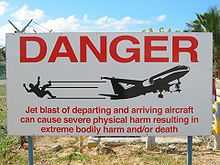Jet blast

Jet blast is the phenomenon of rapid air movement produced by the jet engines of aircraft, particularly on or before takeoff.
A large jet-engined aircraft can produce winds of up to 100 knots (190 km/h; 120 mph) [1] as far away as 60 metres (200 ft) behind it at 40% maximum rated power.[2] Jet blast can be a hazard to people or other unsecured objects behind the aircraft, and is capable of flattening buildings and destroying vehicles.
Despite the power and potentially destructive nature of jet blast, there are relatively few jet blast incidents.[2] Due to the invisible nature of jet blast and the aerodynamic properties of light aircraft, light aircraft moving about airports are particularly vulnerable. Pilots of light aircraft frequently stay off to the side of the runway, rather than follow in the centre, to negate the effect of the blast.
Propeller planes are also capable of generating significant rearwards winds.
Some airports have installed jet blast deflectors in areas where roads or people may be in the path of the jet blast on take off.
References
- ↑ Morrison, Rowena. ASRS Directline, Issue Number 6, August 1993. "Ground Jet Blast Hazard." Retrieved on November 13, 2009.
- ↑ 2.0 2.1 "Ground Jet Blast Hazard". Asrs.arc.nasa.gov. Retrieved 2013-07-05.